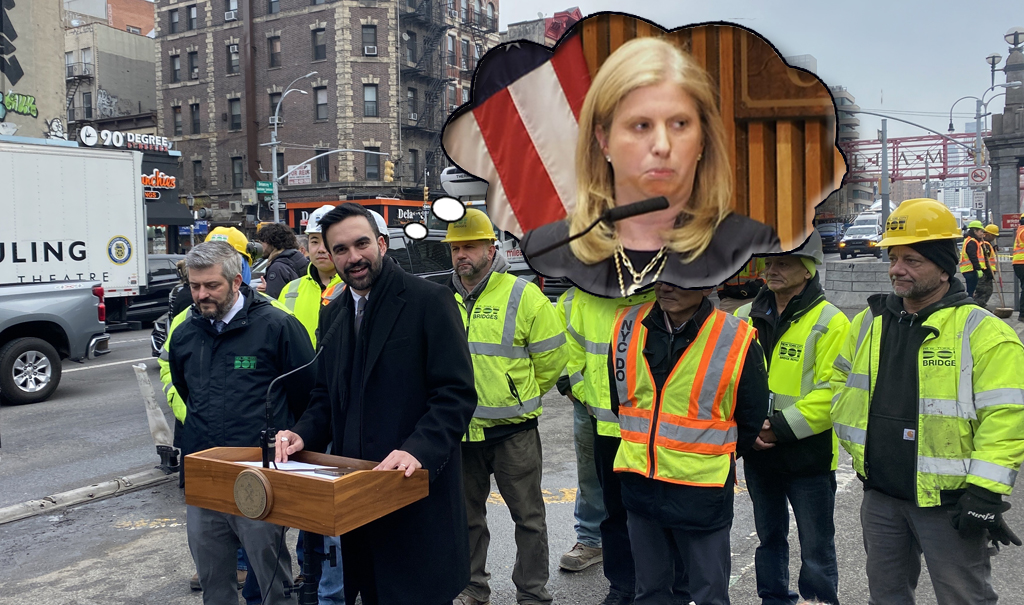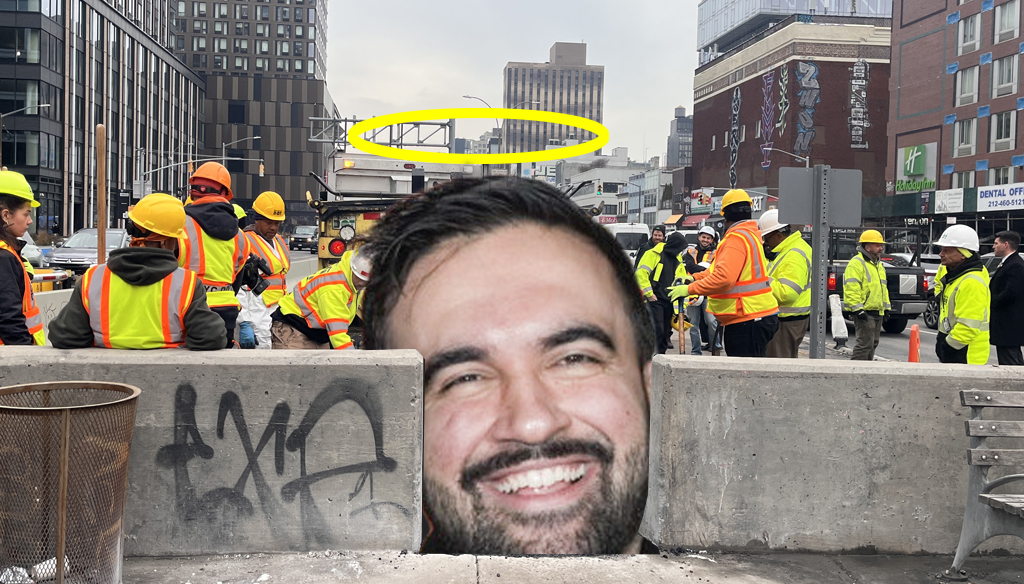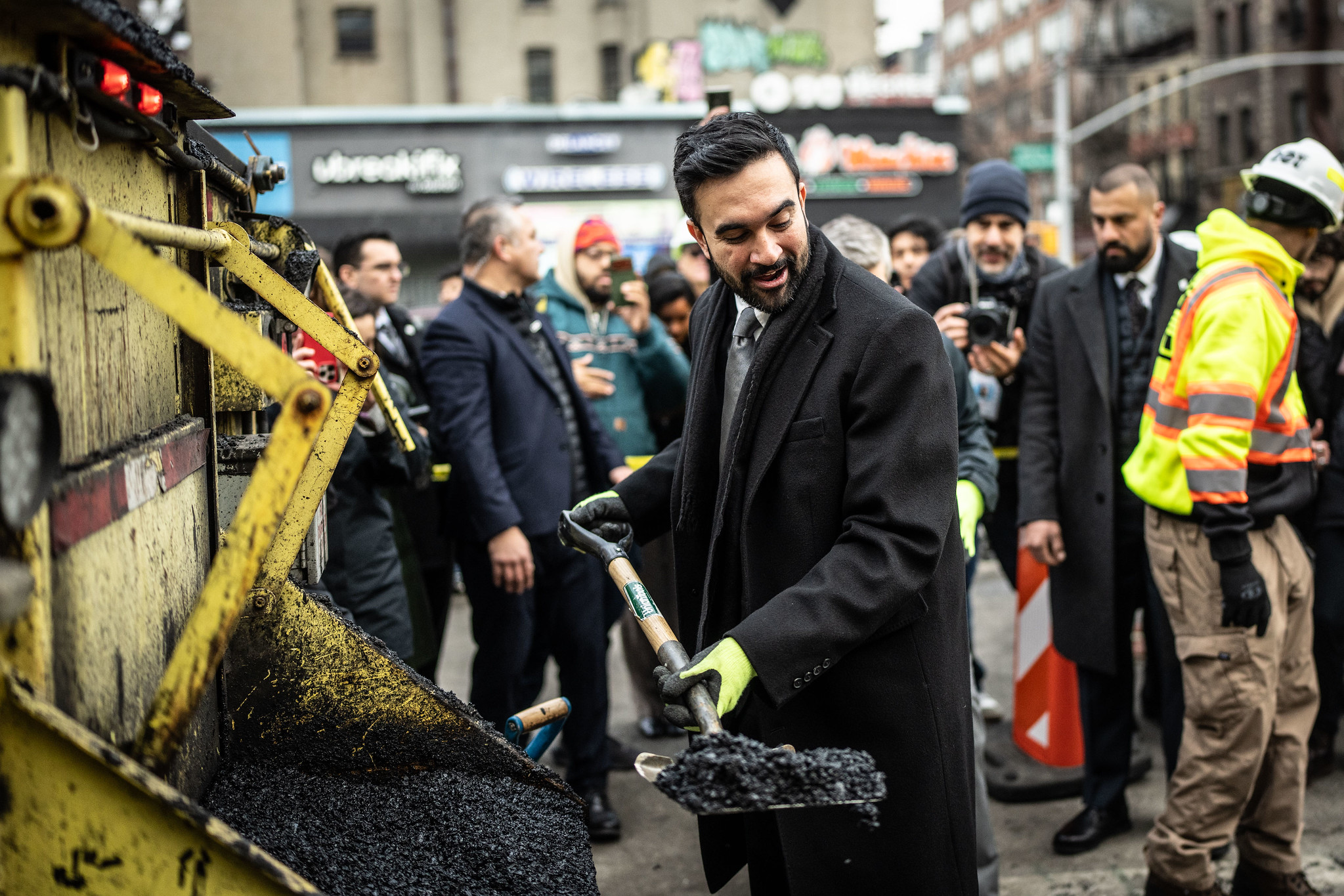 One configuration in the plan calls for a protected bike lane and a curbside bus lane. Image: MTA/NYCDOT
One configuration in the plan calls for a protected bike lane and a curbside bus lane. Image: MTA/NYCDOTThe MTA and NYCDOT released an outline last night for faster bus service and safer biking and walking on First and Second Avenues. The redesign is the flagship project in New York City's plans to enhance its surface transit system by improving bus service, a long-held priority for transportation advocates and a stated goal of Mayor Michael Bloomberg going back to his days as a first-time candidate for office.
At a joint presentation to a group of local electeds and community board members known as the Community Advisory Committee, the agencies laid out a preliminary plan [PDF] to redesign the corridor from Houston Street to 125th Street with protected bike lanes, pedestrian refuges, and a package of bus enhancements. Physically separated bus lanes, viewed by many transportation planners as the most effective method to improve travel times on highly trafficked streets, are not part of the plan.
Advocates and elected officials reacted with measured praise, characterizing the proposal as a starting point which they hope to improve upon. "What was presented tonight is a good beginning," said Assembly Member Brian Kavanagh, who represents the east side of Manhattan, "but we haven't seen enough information from the DOT and MTA to say for sure if we're getting the best bang for our buck in terms of actual transit improvements." The window of opportunity to make adjustments will be dictated by the project timeline, with the first phase of the redesign slated for construction this October.
The design calls for buses to run in a dedicated lane along the
right side of the street, either next to the curb or alongside a parking lane, depending on the location. Despite
support for separated bus lanes from 19 elected officials, the agencies intend to rely on camera enforcement, not segregated rights of way, to keep the bus lanes unobstructed by traffic. Overall, the MTA and DOT estimate the bus improvements will reduce travel time along the route by 20 to 25 percent.
On most of the corridor, the plan calls for bike lanes along the left curb, protected by a floating parking lane. At dozens of crosswalks along the corridor, the design would also install pedestrian refuge islands in this parking lane. If built, it would constitute the longest on-street protected bike route in New York City. Still, as currently conceived, the protected bike lanes are not continuous.
 For a larger version of the corridor map, click here.
For a larger version of the corridor map, click here.On 30 blocks of Second Avenue in Midtown, as well as about 10 blocks of First Avenue south of the Queensboro Bridge, the plan calls instead for a shared route bike lane marked by chevron stencils. According to DOT Bicycle Coordinator Josh Benson, the MTA and DOT were unwilling to continue the protected bike lane through those areas because "the traffic levels are the most intense in the entire city. Every inch of that space is at a premium."
Additionally, all changes to the street are on hold anywhere construction of the Second Avenue Subway is underway. For the time being, there will be no physical alterations to enhance bus service roughly between 70th Street and 100th Street on Second Avenue, and no protected bike lane on Second Avenue between 34th Street and around 100th Street.
When an audience member asked how drivers would know to stay out of the bus lanes, Ted Orosz, the director of long-range bus planning at New York City Transit, contended that the lack of a separated lane would actually make bus operations smoother: "Trucks are going to get to the curb anyway. There'll be a garbage truck. There'll be an oil truck. There'll be a Snapple truck. And the bus won't be able to get around it... A barrier to keep traffic out also keeps buses in." Orosz did suggest augmenting the city's terra cotta bus lane paint with "some sort of soft mountable barrier that communicates, 'Yeah, I'm not supposed to be there'" to drivers.
The plan uses two different bus lane configurations. In one design, planned for First Avenue south of the United Nations, an exclusive bus lane would be offset from the curb, meaning it would be situated between a parking lane and general traffic. In the second design, on Second Avenue below 34th, the bus lane would instead run right next to the curb, with the parking lane eliminated. While the offset bus lane is expected to reduce travel times the most, the MTA and DOT argued that it was inappropriate for narrower or busier parts of the corridor.
 The "Design A" configuration: Class 1 bike lane, off-set bus lane.
The "Design A" configuration: Class 1 bike lane, off-set bus lane.The curbside bus lane poses a greater challenge to deliveries, according to Joe Barr, DOT's director of transit development. "We need to look closely at how this works with loading," he said, suggesting that a midday loading period might be necessary with the curbside design. On the Upper East Side, planners are still studying the business needs along the corridor and have not yet announced whether offset or curbside bus lanes will be installed.
Presenters said Select Bus Service on First and Second Avenues will make use of features piloted on the city's Fordham Road route. Fares will be paid before boarding; riders won't have to show anything to the bus driver, but fare inspectors could ask for a receipt at any time.
The new, articulated three-door buses will also have not-quite-level boarding. The bus floor will be three inches above the curb, less if the bus kneels. "It'll be a much easier and faster on-and-off, but it's not true level boarding like on the subway," said Barr.
Streetsblog will continue our coverage later today with reactions from transportation advocates and elected officials. Here are some plans of each configuration the MTA and DOT discussed last night.
 Design A. Click for a larger version.
Design A. Click for a larger version. Design B. Click for a larger version.
Design B. Click for a larger version. Design C. Click for a larger version.
Design C. Click for a larger version.




